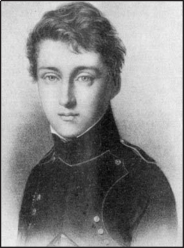- CARNOT
- FRANCE (see also List of Individuals)\
 1.6.1796 Paris/F - 24.8.1832 Paris/F\Nicolas Léonard Sadi Carnot studied from 1812 to 1814 at Ecole Polytechnique engineering sciences and then joined the French army for the following five years. His bent to science led to leave the army. After a visit to Germany in 1821, where his father lived, he returned to Paris and devoted studies to the improvement of the steam machine. The only written document of Carnot was published in 1824. On 118 pages along with one plate, he described the basics of what we currently refer to as the Second law of thermodynamics. After a short stay with the army from 1826 to 1828, Carnot prepared a second manuscript which was published only in 1878 by his brother Hyppolite. His short life came to an end due to cholera.\Carnot's ideas were discovered in 1834 by Emile Clapeyron (1799-1864). They were fully appreciated once Robert Mayer in 1842, James Prescott Joule (1843) and Hermann von Helmholtz (1847) had recognized heat as a form of energy, and the equivalence with work had been demonstrated. William Thomson (1824-1907), the later Lord Kelvin, developed the absolute temperature scale, whereas Rudolf Clausius introduced the notion entropy and demonstrated the irreversibility of thermodynamic processes. Carnot's discovery counts among the most significant in modern physics. His first fundamental finding was that mechanical work can only be produced if the heat flux of one body with a larger temperature flows to a second body of lower temperature. The second important finding of Carnot relates to the maximum work production, provided all changes of state are reversible. The so-called ring-process consists of two isotherms and two changes of state without heat loss nor production, thus refering to the adiabatic process. Possibly, Carnot did not realize the impact of his research that was advanced mainly in the second half of the nineteenth century and is currently an important basis of fluid mechanics where thermodynamic processes are involved.\Carnot, S. (1824). Réflexions sur la puissance motrice du feu et sur les machines propres à développer cette puissance. Bachelier: Paris.Clapeyron, B. (1834). Mémoire sur la puissance motrice de la chaleur. Journal de l'Ecole Polytechnique 14: 153-190.Fox, R. (1988). Sadi Carnot et la leçon de leur édition critique. La vie des sciences 5: 283-301. PKastler, A. (1974). La vie et l'oeuvre d'un grand physicien: Sadi Carnot. Sciences et Techniques17(10): 7-12. PPlank, R. (1932). Sadi Carnot. Zeitschrift des Vereines deutscher Ingenieure 76(34): 821-822. P
1.6.1796 Paris/F - 24.8.1832 Paris/F\Nicolas Léonard Sadi Carnot studied from 1812 to 1814 at Ecole Polytechnique engineering sciences and then joined the French army for the following five years. His bent to science led to leave the army. After a visit to Germany in 1821, where his father lived, he returned to Paris and devoted studies to the improvement of the steam machine. The only written document of Carnot was published in 1824. On 118 pages along with one plate, he described the basics of what we currently refer to as the Second law of thermodynamics. After a short stay with the army from 1826 to 1828, Carnot prepared a second manuscript which was published only in 1878 by his brother Hyppolite. His short life came to an end due to cholera.\Carnot's ideas were discovered in 1834 by Emile Clapeyron (1799-1864). They were fully appreciated once Robert Mayer in 1842, James Prescott Joule (1843) and Hermann von Helmholtz (1847) had recognized heat as a form of energy, and the equivalence with work had been demonstrated. William Thomson (1824-1907), the later Lord Kelvin, developed the absolute temperature scale, whereas Rudolf Clausius introduced the notion entropy and demonstrated the irreversibility of thermodynamic processes. Carnot's discovery counts among the most significant in modern physics. His first fundamental finding was that mechanical work can only be produced if the heat flux of one body with a larger temperature flows to a second body of lower temperature. The second important finding of Carnot relates to the maximum work production, provided all changes of state are reversible. The so-called ring-process consists of two isotherms and two changes of state without heat loss nor production, thus refering to the adiabatic process. Possibly, Carnot did not realize the impact of his research that was advanced mainly in the second half of the nineteenth century and is currently an important basis of fluid mechanics where thermodynamic processes are involved.\Carnot, S. (1824). Réflexions sur la puissance motrice du feu et sur les machines propres à développer cette puissance. Bachelier: Paris.Clapeyron, B. (1834). Mémoire sur la puissance motrice de la chaleur. Journal de l'Ecole Polytechnique 14: 153-190.Fox, R. (1988). Sadi Carnot et la leçon de leur édition critique. La vie des sciences 5: 283-301. PKastler, A. (1974). La vie et l'oeuvre d'un grand physicien: Sadi Carnot. Sciences et Techniques17(10): 7-12. PPlank, R. (1932). Sadi Carnot. Zeitschrift des Vereines deutscher Ingenieure 76(34): 821-822. P
Hydraulicians in Europe 1800-2000 . 2013.
